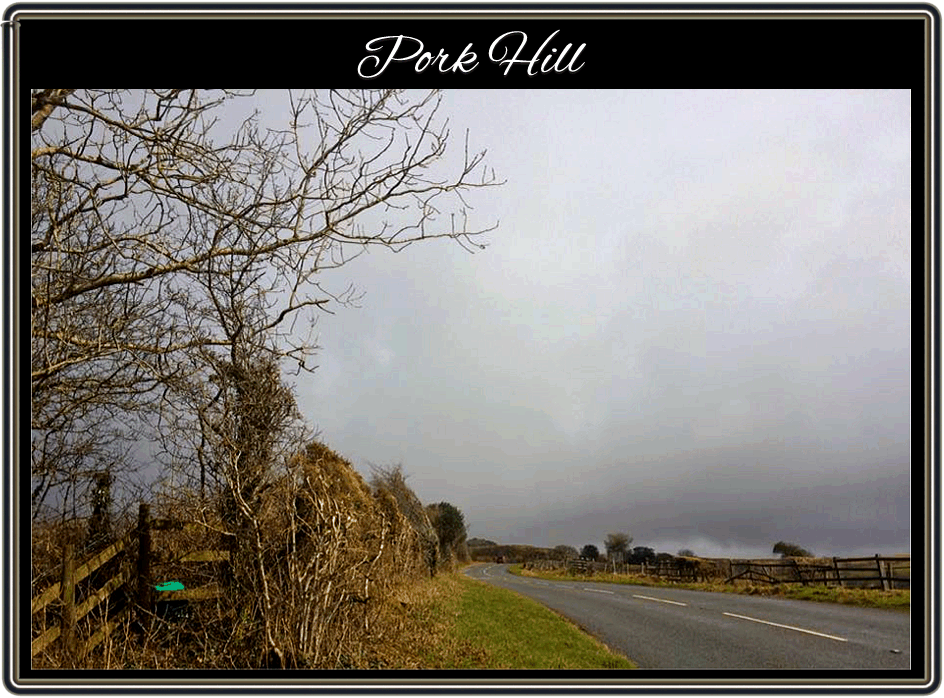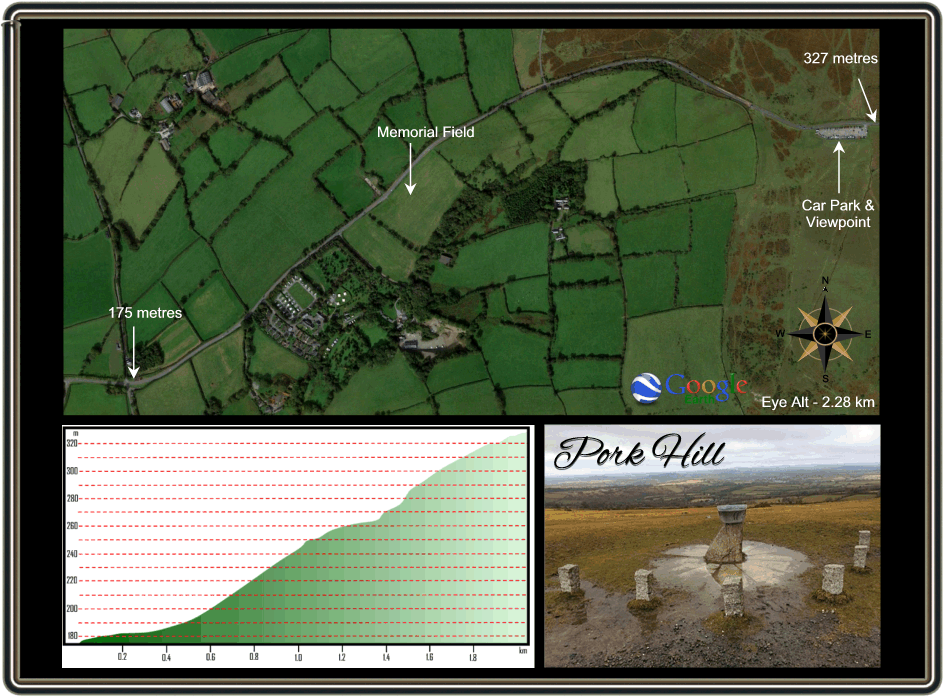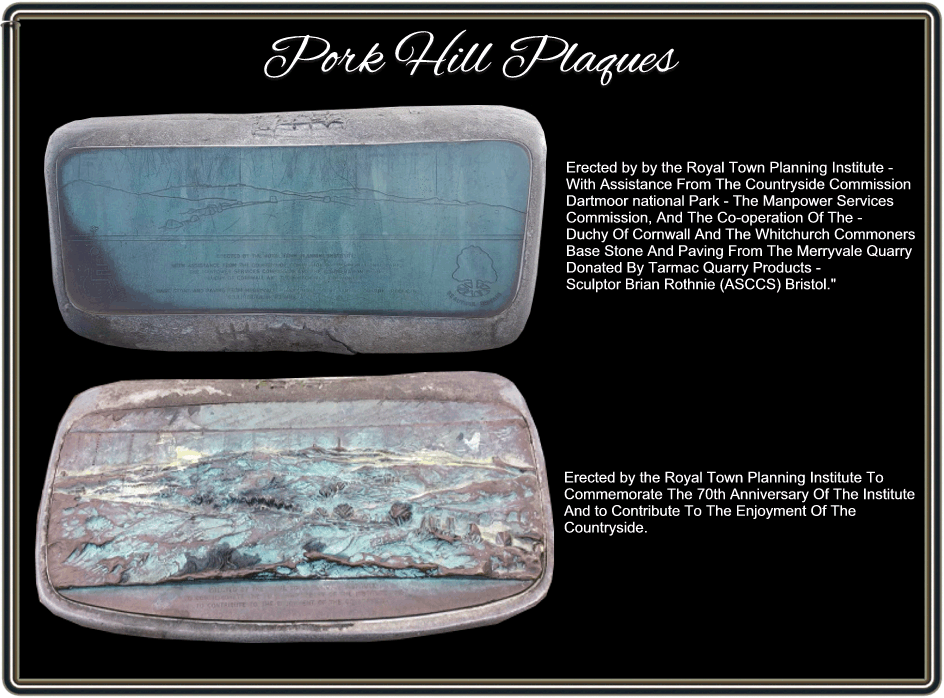
Pork Hill – when travelling on the B3357 from Tavistock to Princetown one will encounter this hill as it winds it way up from the lowest point at Moorshop (175 metres) to the summit just past the car park (330 metres). In all likelihood a lycra-clad cyclist will be encountered puffing and wheezing their way up and probably thinking to themselves; “oh Lord, how much further does this drag on?” In all reality from top bottom to top it will ‘drag’ on for about another 2.06 kilometres when (as far as cyclists go) thankfully it plateaus out under the watchful eye of Cox tor. On the ascent the careful observer will notice a long line of small, possibly vegetation-covered granite posts lining the right-hand kerbside. These are an ominous reminder that what goes up must come down and in the context of vehicles this can prove hazardous – more of which later.
According to William Crossing it was a Mr. Turner who in 1772 managed to get an act passed which allowed for the construction of a road across Dartmoor part of which in now the B3357. The act allowed for repairing and improving the roads from the town and borough of Tavistock to Cherrybrook and on to Moretonhampstead. Part of this road was contracted out to a Mr. Carter and his sons who lived in a ‘rude hut’ near Rundlestone. p.29. This then meant that wheeled vehicles of diverse kinds could now travel across the moor in comparative ease when compared to what was previously a trackway. At first this encompassed a variety of horse drawn contraptions which later gave way to whole gamut of motorised vehicles of all shapes and sizes. Over the centuries the combination of a steep downhill gradient with a precipitous drop on its side and speeding vehicles made for a disaster waiting to happen. Hence the granite posts lining parts of the hill which were placed in the hope that they would act as a modern crash barrier and prevent vehicles from pitching off the road and careering down the slope. In 1993 two girls were tragically killed in a road accident on the hill and in a roadside field sits a memorial stone to the fact.
It is not only the descent of Pork Hill than can prove dangerous for in 1883 a waggoner was killed when ascending the hill. After visiting the Merrivale Inn the waggoner along with a passenger came to Pork Hill when for some reason the waggoner cracked his whip in order to get some speed up for the long climb. The noise of the whip startled the horses which resulted in the lead chain becoming detached. The waggoner leant over the team in order to recover the chain but sadly overbalanced and fell out of the wagon onto the ground when the wheels of the vehicle ran over his neck killing him instantly.
Another strange story attached to Pork Hill occurred at the Tavistock Petty Sessions in 1883 when J. S. Davey the son of Tavistock’s Highway Board surveyor was summoned for having ‘unlawfully and maliciously’ damaged a lamp attached to a traction engine. The engine belonged to Cornelius Duke a granite merchant from Princetown and had been involved in an accident whilst descending the hill. The engine was all but wrecked and was awaiting repairs so it could be moved off the road when Davey passed by. Apparently he was none too pleased with the obstruction and in a fit of road rage lashed out with his whip and smashed a lamp saying; “I’ll smash that blooming lamp before I go home.” However in court he claimed that he was merely pointing out the wreck to his cousin by means of his whip when it accidentally came into contact with the lamp. After much haggling about compensation the matter was finally settled and the defendant was ordered to pay £1 4 s. in fines and costs. The next case to be heard was in relation to Mr. Duke who was charged with obstructing the highway on Pork Hill when his engine ran away. What goes around comes around and then it was the Highway Board’s surveyor Mr. J. S. Davey senior’s turn for revenge. He stated that the engine with two wagons attached was occupying two thirds of the road leaving barely enough room for a carriage to pass. Davey stated that he had asked some men why horses had not be brought to the scene to tow the engine away – their reply was they could get no horses. Mr. Duke’s defence was that in his opinion the only safe way to remove the engine was to repair it enough in-situ so as it could get up the hill under it’s own steam (forgive the pun). The engineer effecting the repairs came from Leeds and he too confirmed that it would have been too dangerous to move the engine until it was working. He also noted that he and another man had been working for over a week in order to fix the machine. He also added that had he been sent for when the accident occurred it would have been fixed within a week instead of the three week interval when it sat obstructing the road. Mr. Duke was fined £2. 2 s. in fines and costs and clearly he did remove the engine as today it is no longer blocking the road.
During the early 1900s Pork Hill was a popular place for motor hill climbs such as the one that occurred on the 1st of June 1908. On that occasions a huge procession of cars, trio-cars, bicycles and pedestrians wended their way up from Tavistock. All the competitors and their vehicles assembled in a field at the foot of Pork Hill, at the top of the hill was the finishing line along with a marquee, Little knots of spectators were dotted along the length of the route to watch the motor cars as they raced up the hill against the clock. There were four classes for each of which a prize was offered for the fastest contender.
Today Pork Hill features in many cycling challenges whereby two wheels instead of four trundle their way up or zoom their way down its gradient. From what I can gather, not being a cyclist, this is one of two ascents that make up the Rudlestone Climb and more famously has previously been part of the Tour of Britain route. The hill also features as the 107 mile long ‘Grande Route’ in the now well established ‘Dartmoor Classic Sportive’ which is run by the Mid-Devon Cycle Club each year. If you fancy watching hundreds of psychedelic riders puffing and straining up the hill then the 2018 event takes part on the 1st of July.
On the Crest of the hill sits Pork Hill Car Park also known as Cox Tor Car Park by some. As locations go there are (at times) four main attractions; the wide yawning panoramic views, the Dartmoor Ponies, the seasonal ice-cream van and the rather out of place granite monolith with two commemorative plaques on of it. You could say there are five attractions if you are into scavenging bird life of various kinds. The big question is why do people visit the place? The simple answer is for various reasons; to stop for a picnic or a workers lunch break, to admire the view, to take the dogs for a walk, as a start point on a moorland ramble, to do a spot of pony peeking, to get an ice cream in order to keep the kids quiet or to turn around because the wrong direction has been taken. However, sometimes there can be a combination of the above and it’s not unusual to see people sat in their cars reading books or newspapers. which always seems a bit odd. Maybe it’s the only place where they can get some peace and quiet in order to concentrate on their reading matter As view points go there can be no question that on a clear day the vistas are spectacular. Ranging all the way across to Cornwall and the heights of Bodmin Moor and in the other direction up to Brentor.
At the western end of the car park sits a granite block upon which sit two plaques one of which labels all the visible landmarks. Sadly being plonked in such an exposed spot the bronze has become weather-worn making the words and map hard to read as can be seen below. Prince Charles unveiled the monument around 1984 (thanks Simon Dell and all) which was erected to commemorate the 70th anniversary of the Royal Town Planning Institute. The words on the top plaque read; “Erected by the Royal Town Planning Institute To Commemorate The 70th Anniversary Of The Institute And to Contribute To The Enjoyment Of The Countryside.” The second plaque situated on the edge of the monument reads; “Erected by by the Royal Town Planning Institute – With Assistance From The Countryside Commission, Dartmoor national Park – The Manpower Services Commission, And The Co-operation Of The – Duchy Of Cornwall And The Whitchurch Commoners – Base Stone And Paving From The Merryvale Quarry Donated By Tarmac Quarry Products – Sculptor Brian Rothnie (ASCCS) Bristol.” Interestingly despite someone taking a lot of trouble designing this plaque they failed to spell Merrivale correctly – a real Hamlet moment for the older generation.
But who or what were/are the Town Planning Institute? The statutory practice of town planning stemmed from the Housing, Town Planning, etc Act 1909. This act allowed local authorities under the close eye of the Local Government Board to prepare schemes for land in the process of being of developed, or likely to be developed. At this time town planning had not established itself as an art or science, but practitioners in the activity were growing in number. Many saw their work as being distinctive within a number of professions which came to engage in this area such as architecture, surveying, municipal engineering and the law. In 1910 Thomas Adams played a leading part in discussions that went beyond mere co-operation of these four practices from. In that year Adams he was appointed as the first Town Planning Inspector at the Local Government Board. He then began to meet regularly with a small group of practitioners, and the notion of town planning being an area of distinctive expertise took hold.
On 11 July 1913 a provisional committee of the group was set up at a meeting in London when a membership list was drawn up. The members came from not the professions and also included amateurs whose interest was in but not directly associated with the subject. The founding meeting was convened on the 21st of November and was chaired by Thomas Adams. 1913. A Council was elected and met for the first time in December at which Adams was elected President on 13 March 1914. An inaugural dinner on 30 January 1914 marked the public launching of the Institute, and the Articles of Association were signed on 4 September 1914. The first three of the objects for which the Institute was established in the Articles of Association were as follows: To advance the study of town-planning, civic design and kindred subjects, and of the arts and sciences as applied to those subjects; 1) To promote the artistic and scientific development of towns and cities, 2)To secure the association, and 3) to promote the general interests of those engaged or interested in the practice of town-planning. Alfred R Potter was appointed the Institute’s first Secretary on 18 December 1914; the Institute’s first London office was established at 4 Arundel Street.
For me the most frustrating thing about Pork Hill is not being able to find any reason as to why it’s so called? Is there some association with pigs? Maybe because of its steep gradient it was a ‘pig of a hill’? Usually when place names are associated with pigs there is some use of the ‘swine’ element as in Swincombe but possibly at one time some event happened with a pig connection? . There is a very vague possibility that the old Anglo Saxon word – port which can allude to a portal, gateway or entrance may be applicable? Clarke Hall, p.274. The reason being that on an ascent the top of the hill is where the open moor begins and conversely on descending is where the enclosed lands begins? Certainly on virtually all of the OS map printed between the late 1800s and mid 1900s the name does not appear on any of them. If anyone has any further suggestions I would love to hear them.
It’s probably worth noting that there is a standing bylaw on Dartmoor which bans sleeping in vehicles or erecting tents within 100m from a road which basically rules out Pork Hill car park as an overnight stop-over.

Clarke hall, J. R. 2004. A Concise Anglo Saxon Dictionary . London: The University of Toronto.
Crossing, W.1987. A Hundred Years on Dartmoor. Exeter: Devon Books.
 Legendary Dartmoor The many aspects past and present of Dartmoor
Legendary Dartmoor The many aspects past and present of Dartmoor



